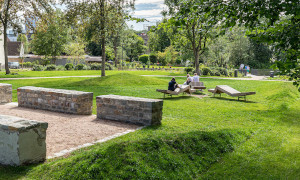Open spaces create identity, enable social participation, and give the public a place. They are stages of social life and are designed as places of encounter, communication and urbanity. As green infrastructures, they positively influence the urban climate and biodiversity.
Landscape architects translate the demands of people into concrete designs of landscaped open spaces. The wide range of these open spaces includes public spaces such as parks and green spaces, play and exercise areas, squares and pedestrian zones, but also privately used open spaces such as home gardens, company gardens and roof gardens.
Open space planning is often closely linked to other tasks related to building culture, neighborhood planning, buildings or infrastructure, and adaptation to climate change. Thus, open space planners also deal with urban planning, traffic, garden monument preservation or urban nature.
The design of open spaces is also referred to as object planning. It is divided into nine different service phases. Landscape architects begin with the actual design task on the basis of the determined fundamentals. Preliminary planning, design, approval planning and implementation planning form the design core of the task. Afterwards, landscape architects participate in the contracting of construction services and supervise them for the client.
The spectrum of open space planning:
- Public parks and green spaces
- Pedestrian zones, squares, promenades, street spaces and parking lots
- Open spaces on buildings for residential, industrial, commercial, offices, hotels, museums, schools and public facilities
- Open spaces for clinics and care facilities, therapy gardens and spa parks
- Residential environment design, improvement
- renovation of green and open spaces
- barrier-free open spaces
- playground planning, children's playgrounds, day care centers and schoolyards
- Garden monument preservation, garden monument preservation target planning
- traffic facilities and infrastructure landscapes
- cemeteries and allotment gardens
- Garden shows, exhibition and leisure parks
- Home gardens
- Plant planning and plant use
- Park maintenance works, garden monument conservation, restoration of historic parks and gardens
- Sports facilities for competitive and popular sports
- Recreational facilities, golf courses, campsites, outdoor pools, beaches
- Green architecture, courtyards, conservatories and indoor green spaces, green roofs and facades
- Animal parks, zoos and animal enclosures
- Educational and health trails
- Outdoor lighting concepts
- Rainwater management
- Latitude: 0
- Longitude: 0

